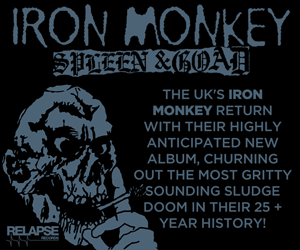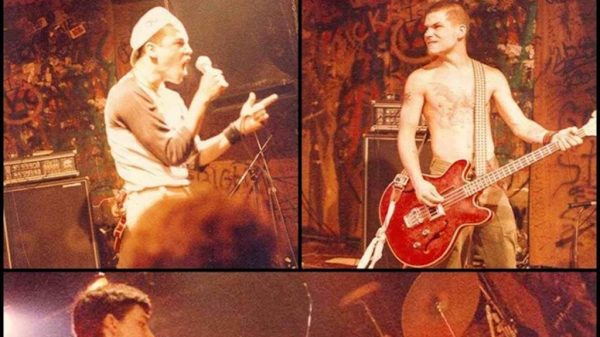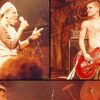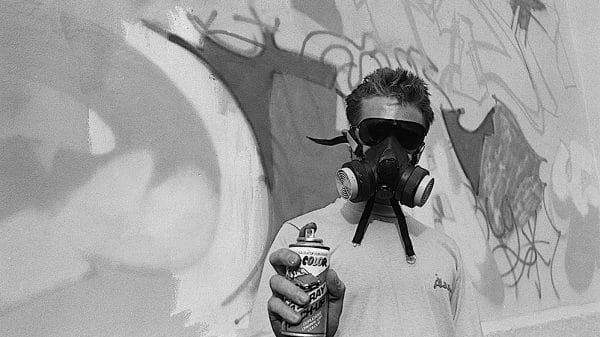Although cult British anarcho-deathrock band Part 1 have already been covered in CVLT Nation, missing from the equation was an interview with the band’s founder, primary songwriter, and guitarist (and, in its late era, the lead vocalist, replacing Jake Baker). Mark Ferelli is a fairly reclusive visual and performance artist who has rarely given interviews, preferring to let his art speak for itself. In this wide-ranging interview, he discusses his relationship with Nick Blinko and Rudimentary Peni, Crass, and Pushead, whose Pusmort label released Part 1’s seminal Pictures of Pain LP in 1985. Eschewing releases on Crass Records and interest from Jello Biafra (of Alternative Tentacles), the band missed reaching a wider audience in its heyday of the early and mid-1980s. Now, however, Mark Ferelli talks about Part 1’s recent reunion, possible touring, and opens the foetid tomb doors onto the archives of his own Lovecraftian art.
Interview conducted April, 2012. All artwork reprinted with permission.
Q: First of all, I think many found out a lot of welcome info, and perhaps even an introduction for the first time, to Part 1 via Ian Glasper’s The Day the Country Died, the recent book about UK anarcho-punk, which probably contains the most info on the band out there in the hands of the general public. Is there anything in there you’d like to correct, or add to, or redact, besides the spelling of your last name (“Farrelly”)?
MARK FERELLI: I think Ian Glasper did a commendable job on that one — getting the info from the “horse’s mouth,” as it were — me! I did see it as a serious opportunity to get down in print the various pieces of chronology that had been floating around, largely undocumented, for a while, so for that I’ll always feel very respectfully in his debt. As to my last name, it changes with whatever I’m doing at the time!
Q: When did Part 1 start, and what does the name mean?
MF: All memory goes back to a particular dark, chilly night in January 1980 with myself and Chris Pascoe (bassist) droning out this lengthy, gloomy instrumental piece I’d called “Part Nine,” a title inspired by “Radio Four” on the PIL album Metal Box, which was a major influence on us both at that time in so many important ways. Not just the music, but that kind of off-center approach the whole thing had. It seemed a bit more adventurous than the dull, staple-diet of UK SUBS, CLASH, et al.-type of formulaic stuff that stood in most minds as “punk rock” at that time. I think it’s safe to say the name PART 1 was an extension of that, something rather oblique but suggestive of a possible, nefarious meaning. I hadn’t really known Chris for too long at that point, me coming from a lengthy history of schoolyard bands, playing mainly with Sean Finnis and Dave Paul who later went on to form the brilliant EXIT-STANCE, but we both were really into experimenting with some kind of different sound whilst maintaining a naturally dark, abrasive attitude.
Q: What prompted you to get into the punk music of the time, and what were the bands at the time that were your “gateway drugs” – that is, the bands that appealed to you the most, and had the biggest impact?
MF: As a kid my great obsessive love had been with all things horror. Those Roger Corman Poe films, paperback collections of short stories, imports of American magazines such as Nightmare, Psycho, and Scream, full of a particular graphic, screaming force. I think punk had an analogous, complementary effect on my growing nervous system; looking back, my two early “gateway” bands were The Stranglers (first three albums) and Siouxsie and The Banshees (first two albums). Also, add to that that first PIL album as a follow-up. The summer of 1979 saw the release of my two most favourite punk records of all time, though: the ‘Stamp Out Normality’ EP by Lincolnshire band the Pseudo Existors and the ‘Split Single’ EP of UK Decay/Pneumania, both of which had a major effect on me!
Q: As far as your guitar playing style, who was the biggest influence on that?
MF: My first impressions of grabbing an electrical guitar about the neck was one of great disappointment! I had neither the volume nor the wherewithal to eke out the sounds required. I was left haunted, scarred for life, and permanently intimidated by John McKay’s amazing guitar work on the Siouxsie and the Banshees track “Voices,” the 1978 b-side of “Hong Kong Garden.” It’s safe to say that sound kind of ripped my mind apart, even raped me. There was a beautiful story doing the rounds at the time on how pub landlords used to play that record on the jukebox at closing time to clear the premises! And with the album Join Hands that particular, unique use of a flanger hit some kind of zenith. That really is the John McKay masterpiece and its influence has clearly run through all the many flanging reverberations that followed from others over many years. Sadly, its a currency long debased and made largely mediocre by its boring, unimaginative use by countless arsehole Goth bands. My fortune was using an effects set-up that wasn’t really that common, though it did say “flanger” on the box!

Q: Is it true that you are the character “Simeon” in Nick Blinko’s novel The Primal Screamer?
MF: Good try, Oliver! From my reading of it, I think ‘Simeon’ is in fact based on (Rudimentary Peni bassist) Grant Matthews, whilst I appear in the later chapters as an overly pale, effete, and waif-like punk called “Farinelli” (named after the famous Seventeeth Century castrati — cheers, Nick!) in those scenes presenting some grotesque parody of the East London Autonomy Center, the early 80s venue funded by Crass. I had long lost contact with Nick when I first read it but recognised many of the characters and anecdotes within it. For instance, the railway worker who returns to the scene of a trackside suicide to find his companion stirring the brains of a dead body with a stick. That was a story told to me by my father.
Q: How did you meet Nick Blinko and what were some of the high points of your friendship?
MF: Firstly, I’d met Rudimentary Peni bassist Grant Matthews one evening at the East London Autonomy Center, late December, 1981. Every other Sunday evening there was a number of gigs there, mainly with The Apostles and a number of associated bands and persons largely squatting in North London, who’d set-up a kind of informal residency there. Crass were funding the place, as far as I could gather, but were very rarely seen there! Occassionally they would appear, making tea and smoking hand-rolled cigarettes, but for the large part it was the work and dedication of people like Andy Martin (singer of the Apostles) that kept the place brimming with energy and interest. He was someone I’d met for the first time at the two abortive, legendary squat-church gigs in London’s King Cross earlier that same year, following much tape-swapping and letter writing. These were the seeding days for many subsequent associations, i.e. we were all flogging early demo tapes to each other through a myriad network of homegrown fanzines at that time.

MF (cont.): Grant Matthews seemed to be the only member of Rudimentary Peni that frequented those fairly raucous Sunday nights. Easy to spot, as far as I can remember, as he probably was the sole person who made their way home via the night train, totally sober. It was during one of those journeys back to the ‘shires in the small hours that I accosted him, rather drunk, expressing how much I liked “Teenage Time Killer.” From the abject look of horror on his face at my boozey enthusiasm I think he was glad to get off at his train stop. But we did meet again the following weekend where he gave me a tape of that first, ten-track Peni disc, the initial vinyl pressing having just sold out. I for my part gave him the Part 1 demo “In The Shadow of the Cross” and, not surprisingly, a mutual appriecation society was born!
MF (cont.): With this cassette had come the sleeve for the vinyl and an odd, vicious little comic book penned by none other than Mr. Nick Blinko. Of course, it all appealed to my latent morbidity, and with Grant telling me how much Nick liked Part 1, I was looking forward to meeting him that next Sunday when he, too, was coming down on a rare excursion to the Wapping Autonomy Center. Again, I was very drunk and my first meeting with Nick was pretty inauspicious, feeling he seemed very defensive about his drawing technique (which I was keen to reveal) and he seemed much ill-at-ease. All perfectly understandable when faced by such drunken, needling attentions! But fortunately it was at another thankfully more sober occasion that I had the privledge of meeting and getting to know this very lovely, sweet, and darkly humourous guy, and all the macabre inhabitants of his inner world.
MF (cont.): We began a very bizarre period of correspondence; all manner of curious morbidities travailed the southern English postal system. It was around this time I was visited by an inspector from Her Majesty’s Royal Mail Service as on an envelope I’d inscribed a particularly blasphemous drawing. This had been intercepted, so what with my track record I was a little nervous at what would arrive through the post from Nick. I suppose my favourite was the minature bandage coffin with the model-clay figure that had his own hair dressing its head. Yes, I’ve still kept that one. Though, after thirty years the toxic-looking ‘Grolley Bag’ he also sent, bubbling with some sticky green ichor, has long since dried to crystals and dust….

Bandage-wrapped coffin by Nick Blinko with Blinko's hair on doll head. Text on top reads: "Takes good care of my baby."
MF (cont.): As mail correspondence lost out to the need for deeper familiarity, we began fairly frequent day visits to our respected parental abodes. Nick lived with his folks about forty-five minutes of a train ride distant, so we alternately paid each other a call, spending the day poring over each other’s books and drawings. The first occasion Nick asked to see more of my scribbles I was much shamefaced; I had so little compared to the precious black-bound volumes of sketchbooks where he rendered his particular, peculiar “black letter.” I had nothing! He pressed into my hand what he referred to as “the Bible,” a 1979 art exhibiton catalogue for the show “Outsiders” at London’s Hayward Gallery. To be honest, I still much preferred the art of my old ‘seventies Skywald horror mags, my beloved issues of Eerie and Creepy, well over the dubious merits of some old lunatic tosser in an 18th century Austrian sanatorium. But, hey! We had much to exchange, and exchange we did. I was shocked to find he’d never heard of Howard Phillips Lovecraft; he was shocked that I knew next to nothing of the beautiful writings and drawings of Mervyn Peake. Of course, after I suggested he take a look at “Pickman’s Model” by Lovecraft the die was truly cast and he was supping on those taproots of Yuggoth like nobody’s business. Whilst he was begging to get his mits on the rare Victor Gollancz hardback editions of At The Mountains of Madness and The Haunter of the Dark and Other Tales of Horror I’d long “borrowed” from the local library, I was totally obsessed with the Cthulhu Mythos and working on a number of paintings for a Cthulhu-themed Tarot deck.
Over time we developed a very active mutual appriecation society, competitive only in the sense of literally going as far as each imagining would take us, drawing after drawing after drawing, though to what public end neither of us seemed adept enough in worldly, commercial ways to find out. The galleries seemed a closed world to us. The thought of illustrational work, through self-publishing or some third party, only brought about growing feelings of anxiety and resentment toward some other institutional “system,” much like all the ranting and raving was about in our musical lives of Rudimentary Peni and Part 1. Unemployed, lonely, and unemployable, we relied on state benefits to fund “Death’s Dream Factory,” as I called that period of work. We were petrified at the prospect of any letter from the local goverment office. I produced “Twenty-One Drawings of Horror” at my Lovecraftian peak, while Nick showed me a beyond disturbing series of drawings of figures slowly immolating themselves on spidery, sharpened staves…
MF (cont.): What did slowly occur was the complete inactivity of Rudimentary Peni following the release of their Death Church LP and the serious illness of Grant Matthews. Then came the demise of Part 1 in April 1983, following a disastrous gig at London’s 100 Club with The Subhumans. Both Nick and I entered a form of reclusive “Horror Bubble.” Looking back, the works produced in the “bubble” were tremendous, intense and really quite insane. With all the band inactivity during 1984-1985-1986 there was much talk of us doing something together, John Loder frequently offering free studio time, of writing horror plays for radio, of stage happenings, exhibitions, books, etc., etc., but nothing concrete emerged. The Horror Bubble was too strong, its reclusive delights held Farrelly/Ferelli/F. and Blinko fast. This and a deep fear of the outside world. It was far safer for us both to hold the sum illusion of being Lovecraft’s two protagonists in “The Hound” perversely combined with the two Uxbridge asethetes of Evelyn Waugh’s “Brideshead Revisted.” Though for us it wasn’t so much “strawberries and cream and the dreaming spires of Oxford” but more “a fear of the dark and some morbid terror of ejaculation.”
MF (cont.): Whilst Nick began slowly to emerge from the Horror Bubble in the late nineteen eighties, gaining obvious momentum in his writings with the beginnings of what later became The Primal Screamer, I did my own Arthur Janov-style retreat, screamed, shoved him out of the Horror Bubble and made its once iridescent surface so bleak, black and opaque that all the legions of Nick Blinkos this side of Tarturus would never have a hope in Hades of detecting me for the next twenty-five years — and I kind of succeeded! We went separate ways many years ago now, but it’s a comfort to see how his true genius has been widely recognised without the loss of authenticity.
Q: What have you been doing since Part 1 broke up? I have seen the film about your Magick Lantern show — could you describe to readers what, exactly, that is, and what it consists of?
MF: Not an easy question! But I’ve done much of a varied creative nature, including papier-mache sculpture in Mexico City through to working for a good few years in antique restoration with “The House of Automata,” where I finally got to meet the Abominable Dr. Phibes and his Clockwork Wizards. Probably the greatest experience of my existence so far! Over the years there has been many drawings, an unpublished novel, sculpture, and painting shows. My archive is extensive and I’m looking to catalogue and get this stuff published online now. The past nine years has seen a series of spoken word performances, here in the UK, with visuals provided by Magic Lantern, which is a late-nineteenth century form of slide projector, using my own glass slides and accompanied by a written narrative. “Devil Daddy” was my last show at the Divus Gallery in Prague, a form of ghost story exploring the settings of the 1970 British horror film Blood on Satan’s Claw.

Q: Is it true you and the other ex-members of Part 1 have gotten back together and are going to start playing out? Any new songs? How’s it going?
MF: Such is the vogue these days that it seems everbody and anybody is brushing the earth off themselves to get back together! So yes, it’s true, but what made it so interesting was that yawning gulf of years inbetween (28 years plus) that made me feel so curious whether such a thing could be done and just what would it sound like? For many years I was in denial of Part 1, out of contact with the others for a very long time. It’s been intriguing to see and hear what the others have been up to! Both Chris Pascoe (bass) and Bob Leith (drums) have cut a legendary niche for themselves in respective musical fields. Jake Baker (vocals) is an amazing writer and painter. The reform has fuck-all to do with some misguided grabbings at past flowers of youth. We were always old! I hated being young, it really fucking sickened me. “Archaic” and “eldritch” were always high on the mission statement! So playing again has been a great experience and it sounds gloomier than ever after taking on the experience of life’s emotional hard knocks. We are all very pleased. There are no new songs but we are looking to record the tracks we wrote in the 80s, but never got the chance to do in the studio, so that’s exciting. As for shows, I’m hoping we can do something, especially with the 30th Aniversary release of Pictures of Pain coming up in 2015!
Q: Is it true that Crass wanted to put you all on a compilation, but you all decided against it? Any regrets over that? (Seeing as how bands like Chumbawamba, Bjork, etc., got their start that way, heh.)
MF: Who? Well, I think an offer to appear on Bullshit Detector, Volume 2 was a step below what was REALLY required — i.e., an offer of an individual release on Crass Records itself or its sister label Corpus Christi — hahaha! But yes, I decided against it because we were just about to release “Funeral Parade” on our own Paraworm Records, and they wanted to put out the ancient, UK Subs-y sounding “Marching Orders” track from our January 1981 demo tape! No fucking way! Hahaha….
Q: What was your relationship with Brian “Pushead” Schoeder like? You, Nick, and Pushead are three of the better horror punk type artists out there, so to think of you three collaborating or working together on anything is kind of cool. Did you ever trade art with Pushead?
MF: I began to correspond with Pushead after Nick had given him my address. I was very excited, not because of who or what Pushead was, but here was possibly a friend in the USA who could mail me over all those back issues of horror mags I’d seen but could never get since I was a kid! It was only later that I began to appriecate what a great bloke and genius artist Pushead was, and so much into Part 1 that it was unreal. It’s a shame his enthusiasm came at a time when I was travelling in the complete opposite direction, feeling total apathy, even hatred, toward any mention of Part 1 since the grave demise of the band in Spring 1983.
This really is typified in my lack of involvement in the whole production and release of Pictures of Pain on the Pusmort label in 1984-1985. At no time did I even offer to do any artwork for it. Pushead himself had to copy my classic “spectral hands” motif whilst Nick Blinko very sheepishly informed me that he, too, was working on the back sleve and label art. For me, Part 1 had died an ugly, upsetting death two years prior, so the prospect of Pictures of Pain just left me cold. I still had hundreds upon hundreds of unsold copies of the Funeral Parade EP to destroy! I remember John Loder ringing me at my grandmother’s house asking me if I wanted a copy of the test pressing sent to me. So very reluctantly I agreed, like someone under pain of death, requesting that he never call me at that number again. It was the Summer of 1985. And then a letter from Jello Biafra with sincere enthusiasm about Part 1. I remember feeling tears of anguish and just destroying the letter into atoms.
MF (cont.): But to go back to a more positive time, the first I knew of Pushead was through Nick and the mail he was recieving from him, mainly curious delights like those great early issues of RAW magazine with all the Art Spiegel stuff, etc. I sound like such an oldie but this was before the web, so such packages were of a rare, exquisite wonder to us back then! It’s kind of a “dream team” scenario to think of some work between FARRELLY/BLINKO/PUSHEAD, but I think the very Universe itself would have wept and revolted in some vast, impossible decay… I did send Pus some of my “Twenty-One Drawings of Horror,” one of which, “The Corpse Pendulums,” (above) ended up in Maximum Rock ‘n’ Roll!
As to thoughts on the great Pus himself, I lay prostrate and eternally grateful that his energies at least saved Part 1 from even greater blight and obscurity, and that the Pusmort release has secured some unique little spot in empathetic minds of an equally dark, deathly aspect.
Q: What are your favorite authors? I think HP Lovecraft is a given (or is it)?
MF: The British author Martin Waddell wrote some very special short stories during the 1960’s. For complete unease its got to be Arthur Machen. And there’s that short French horror tale — the woman who wears that specially designed corset that malforms her unborn children into exotic freaks, so that she can sell them to the circus. Maupassant, I think? Tend to daydream about that one a lot.
Q: Please let us know of any upcoming plans you have, either with Part 1, or pertaining to any solo projects, performance art, etc., you might have going on!
MF: I’ve an upcoming exhibiton of drawings this May in South London. Part 1 are rehearsing for a studio date and recording this Summer. All Magic Lantern business is on hold as a new project is under development. Cheers!
*******
Below are selections from Mark Ferelli’s “Twenty One Drawings of Horror”:
Ferelli portrait courtesy Maud Larsson, Horse of Bone photography.





































